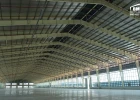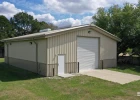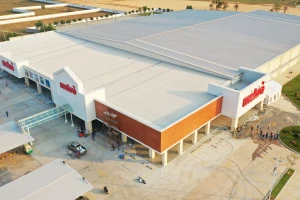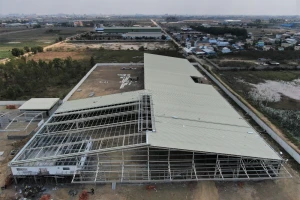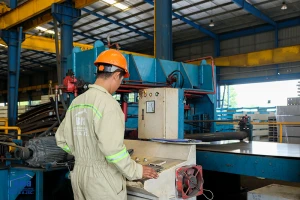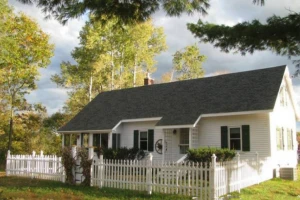10+ effective, safe ways to prevent factory roof leaks
- 1. Identify the causes of factory roof leaks
- 2. How to inspect a leaking factory metal roof
- 3. 10+ effective ways to prevent factory roof leaks
- 3.1. Repair small holes with specialized sealant
- 3.2. Apply waterproof and heat-resistant roof paint
- 3.3. Apply self-adhesive bitumen waterproofing membrane
- 3.4. Waterproofing corrugated metal roofs with sika materials
- 3.5. Waterproofing with asphalt
- 3.6. Fixing leaks on metal roofs using gasoline and foam
- 3.7. Replacing rusted screws, reinforcing loose fasteners
- 3.8. Repairing sagging, deformed metal roofs
- 3.9. Sealing the gap between metal roof and wall
- 3.10. Sealing joints between metal sheets
- 3.11. Waterproofing corroded metal roof due to weather
- 4. Price list for industrial metal roof leak repair services
Over time, metal factory roofs often suffer from water leaks, which can seriously affect production, equipment, and worker safety. To prevent factory roof leaks effectively, it’s essential to identify the root causes and choose the right solution based on the level of damage. In this article, BMB Steel shares over 10 safe, effective, easy-to-apply methods to help you fix leaks, reduce maintenance costs and extend the lifespan of your factory roof.
1. Identify the causes of factory roof leaks
To select a durable and effective solution to prevent factory roof leaks, the most important step is to clearly identify the root causes of water seepage. Understanding the problem accurately will allow for proper repair and help prevent recurring leaks that could disrupt production. Below are some common causes:
Corrosion at screw points on the metal roof
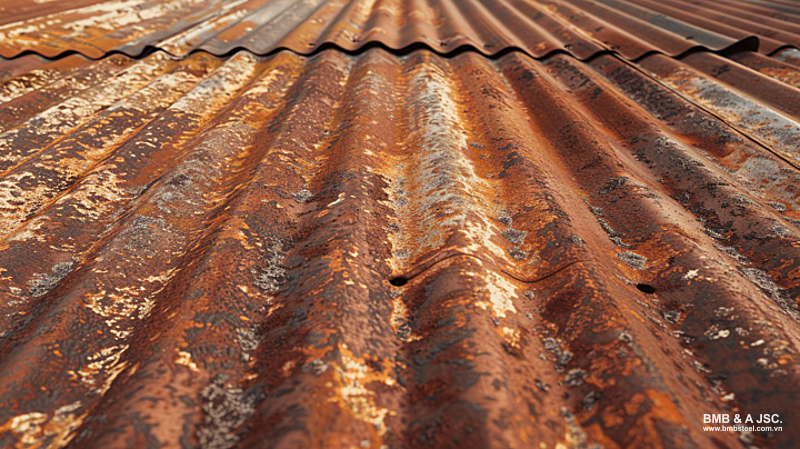
Metal roofs are constantly exposed to harsh weather conditions. As a result, screw points may become corroded or cracked, creating gaps that allow rainwater to seep through.
Inefficient drainage system
An inefficient drainage system, such as undersized gutters, clogged pipes, improper slopes, can prevent rainwater from draining properly, leading to water accumulation and potential leaks.
Exposure to industrial environments
Factory environments often involve corrosive chemicals, steam, and mechanical impact during production. These factors can accelerate the deterioration of walls, floors, roofs, making them prone to cracks and water seepage.
Initial construction errors
Some leaks may be caused by mistakes during the initial construction phase, such as poorly applied primer, waterproofing layers, incomplete plastering, improper treatment of joints.
Lack of timely repairs
If previous leaks are not thoroughly repaired, the damage can worsen over time. Once the protective surface is compromised, rainwater can penetrate deeper into the structure.
Intrusion of plant roots
Roots or moss growing on the roof can puncture waterproofing layers, allowing rainwater to leak into the building at multiple points.
Poor installation of additional equipment
Installing extra equipment like solar panels, water tanks, etc. without proper techniques can compromise the structural integrity of the metal roof, create holes or weak points that eventually lead to water leakages.
2. How to inspect a leaking factory metal roof
In the peak of the rainy season, heavy and unexpected rains frequently occur. That’s why it’s important to inspect your factory's metal roof early to detect any damage in time. Below are 2 simple methods you can try:
Visual inspection
On dry days, you can climb onto the metal roof and visually examine it for signs of damage, such as rust, corrosion, rotting panels, visible cracks and gaps at the joints, etc. Mark any suspicious areas that might leak, so you can return for a more thorough inspection or perform timely repairs.
Water spray test
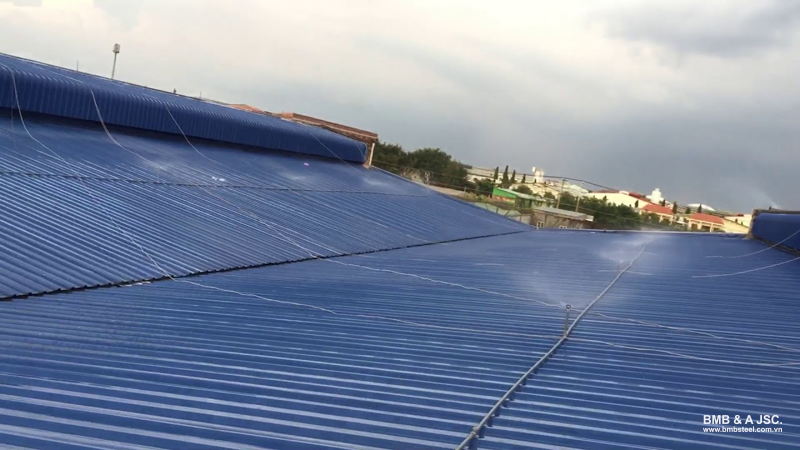
Another effective method is to use a water hose to spray directly onto the roof, simulating actual rain conditions. Start by placing the hose at the highest point of the roof to allow water to flow evenly across the surface. Then observe from underneath to detect any leakage or dripping. Mark each leaking spot to prioritize repairs in order of severity.
Safety tips when inspecting a metal roof
- Only walk on the purlin lines (the rows between screw lines).
- Wear proper safety gear, including a harness, non-slip shoes, and have someone assist you from the ground.
- Avoid inspecting the roof during rainy, windy conditions or when the surface is wet.
3. 10+ effective ways to prevent factory roof leaks
3.1. Repair small holes with specialized sealant
Damage level: Minor
Durability: Over 1 year
DIY capability: Can be done yourself
Benefits:
- The sealant is made from silicone and reinforced with fiberglass mesh.
- Silicone has high elasticity, adheres well to many surfaces like metal, steel, wood, etc.
- It is resistant to aging over time, reduces cracking, suitable for both temporary and long-term use.
Construction guide:
- Small holes: Use silicone sealant or cement to fill the hole. For holes smaller than the size of a self-drilling screw, insert the screw first, then apply the sealant to ensure a tight seal.
- Large holes, long tears: Clean the surrounding area, then use a metal patch that is at least 10 cm larger than the damaged area on all sides. Adhere this patch over the damaged spot using the specialized sealant.
3.2. Apply waterproof and heat-resistant roof paint
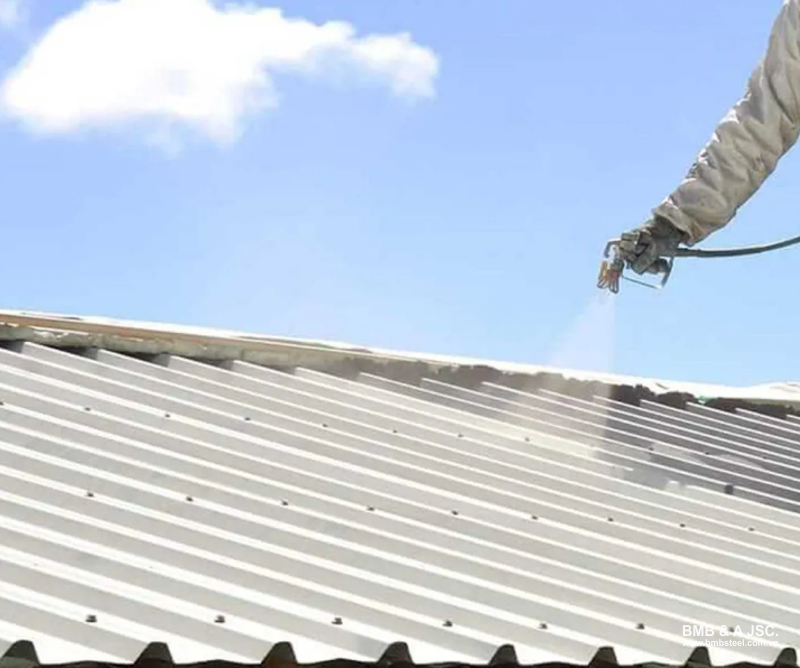
Damage level: Minor to moderate
Durability: 2-3 years
DIY capability: Can be done yourself
Benefits: Combine waterproofing and thermal insulation, effectively reduce heat, forms a protective barrier.
Construction guide:
- New roof: Clean the surface with water, then apply paint according to the manufacturer’s recommended mixing ratio. Apply 2-3 coats depending on usage needs for optimal waterproofing performance.
- Old, rusty roof: Use sandpaper to smooth the surface before painting. Apply 3 coats, spacing each coat about 3 hours apart to allow proper drying and adhesion.
3.3. Apply self-adhesive bitumen waterproofing membrane
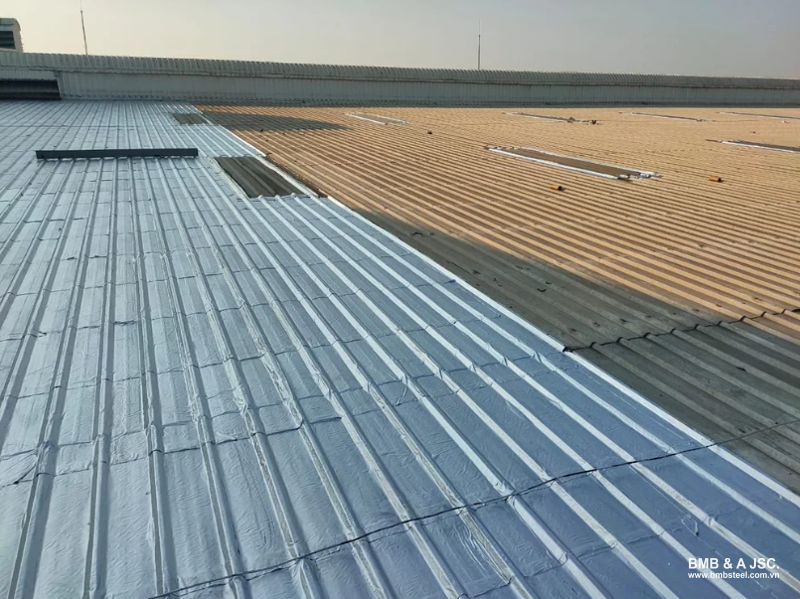
Damage Level: Moderate to severe
Durability: 3-5 years
DIY Capability: Should hire a professional
Benefits:
- Self-adhesive bitumen membrane is made from high molecular polymer combined with bitumen.
- It is waterproof, highly elastic, adaptable to various environments.
Construction guide:
- Clean the roof surface thoroughly, removing dust, mold, peeling paint, and ensuring the surface is solid and dry.
- Apply a primer to enhance adhesion, then wipe off any remaining dust.
- Evenly spread the waterproof membrane over the roof, aligning it properly without deviation.
- Peel off the protective silicon layer, adhere the membrane to the roof from the center outward to the edges, use a roller to press down firmly to eliminate air bubbles and enhance bonding.
- Apply an additional layer of cement mortar, 20–50 mm thick, over the membrane to secure it and provide added protection against physical impact and environmental wear.
3.4. Waterproofing corrugated metal roofs with sika materials
Damage level: Moderate
Durability: 3-5 years
DIY capability: Requires experienced personnel
Advantages:
- High durability at a reasonable cost.
- Deep penetration, compatibility with various surfaces.
Construction guide:
- Clean the damaged or deformed metal roofing area by removing rust, dust, ensuring it is dry. Apply Sika Multiseal (bitumen-based, self-adhesive, aluminum-coated, 4-layer) over the area to be treated.
- For screw heads, clean thoroughly and seal tightly with Sikaflex 11FC (PU-based adhesive) to ensure a strong bond.
Note: Always wear gloves and safety gear during application. If adhesive gets into the eyes or onto sensitive areas, rinse immediately with water and seek medical attention.
3.5. Waterproofing with asphalt
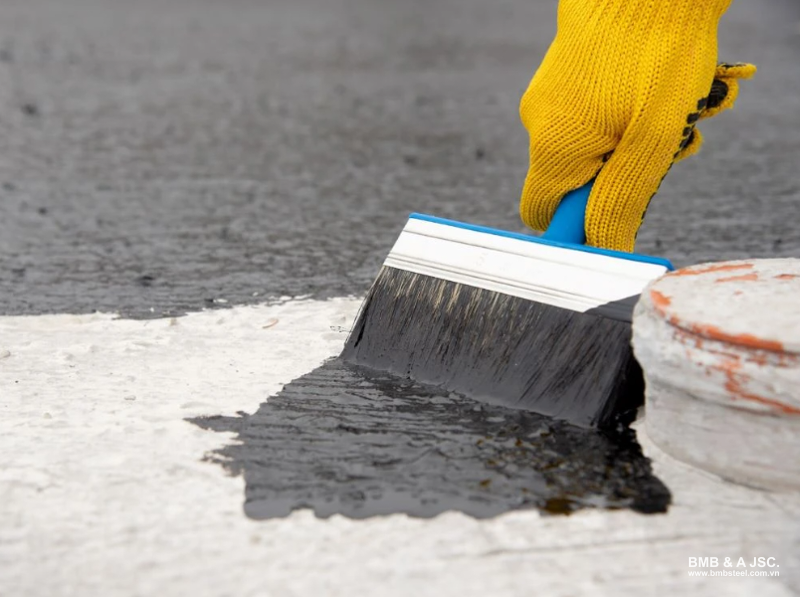
Damage level: Moderate to severe
Durability: 2-3 years
DIY capability: Requires skill or professional assistance
Benefits:
- Highly effective waterproofing, especially when applied in sunny conditions.
- Inexpensive, easily available materials.
Construction guide:
- Clean the surface.
- Heat the asphalt, apply evenly to the targeted area using a brush or scoop. For large holes, reinforce with plastic or fabric patches.
- Allow to dry for 3 hours to complete the process.
Note: When using asphalt sheets, ensure they are applied smoothly without wrinkles. Overlap the sheet edges by 10-15 cm, and extend the sheet 15 cm up the wall where applicable. Reinforce weak points such as wall bases, pipe collars, expansion joints with a layer of asphalt primer.
3.6. Fixing leaks on metal roofs using gasoline and foam
Damage level: Minor
Durability: 6 months to 1 year
DIY capability: Can be done by yourself
Construction guide:
- Clean the leaking area thoroughly. If there are stubborn stains, sand the surface with sandpaper.
- Dip a small piece of foam into solvent gasoline and dab it directly onto the leak.
- Repeat this process until the hole is completely sealed.
3.7. Replacing rusted screws, reinforcing loose fasteners
Damage level: Minor
Durability: 6 months to 1 year
DIY capability: Easy to do
Screws used for metal roofing typically come with rubber washers to provide sealing and stability. Over time, rainwater can cause them to rust and loosen.
Construction guide:
- Remove the damaged screw from the metal roof.
- If the hole is still small, insert a new screw directly.
- If the hole has widened due to rust, apply silicone sealant to fill the gap before installing the new screw.
- Tighten the screw securely to ensure safety.
Note: Replace screws one at a time to avoid roof misalignment during strong winds.
3.8. Repairing sagging, deformed metal roofs
Damage level: Moderate to severe
Durability: 2 years or more
DIY capability: Requires a professional
Construction guide:
- Use screws to fix into the raised rib near the dented area. Then, tie a wire to a stick and gently pull the sagging section back into its original position.
- Perform the task gently, avoid stepping on the damaged area. Once the metal roof is realigned, support it from below using a galvanized steel box section (or any steel bar) to keep it in place and prevent future sagging.
3.9. Sealing the gap between metal roof and wall
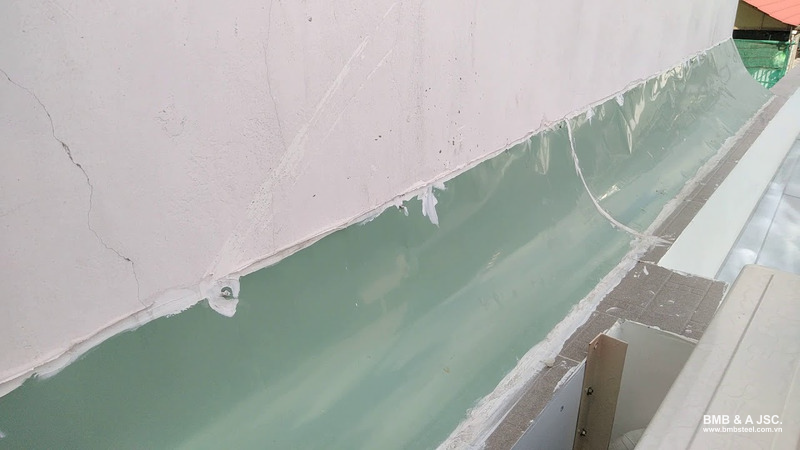
Damage level: Moderate to severe
Durability: 3 years or more
DIY capability: Requires a professional
Construction guide:
- Method 1: Use cement mortar to fill and seal the gap between the metal roof and the wall to prevent rainwater from penetrating the joint.
- Method 2: Apply waterproof sealant along the joint between the two roof sections, or install a metal flashing sheet 10-20 m wide (can be cut into 5 m sections). Fix it in place with nails or screws to prevent wind from lifting it.
3.10. Sealing joints between metal sheets
Damage level: Moderate
Durability: 2-3 years
DIY capability: Requires a professional
Construction guide:
- Apply silicone sealant: Inject sealant into both sides of the metal sheet joint, then press lightly to ensure even distribution, allow the sealant to dry completely.
- If joints are rusted: In case of rust or gaps at the seams, place a new metal sheet approximately 1 m wide over the joint, fix it with screws and adhesive.
3.11. Waterproofing corroded metal roof due to weather
Damage level: Mild to moderate
Durability: 3-5 years
DIY capability: Can be done yourself
Metal roofs exposed to acid rain, harsh sunlight and UV rays tend to deteriorate. These factors degrade the protective layer, leading to oxidation, corrosion and eventually holes.
Construction guide:
- Remove dirt, moss and debris from the metal roof. Use a water sprayer combined with cleaning solution to deep clean the surface, ensuring better paint adhesion.
- Apply anti-corrosion or waterproof oil-based paint. Spray or brush a thin, even layer over the entire roof surface to form a protective barrier against water, UV damage.
4. Price list for industrial metal roof leak repair services
You can easily purchase various types of leak-sealing adhesives at construction material stores, hardware stores, or order online via e-commerce platforms such as Shopee, Tiki, Lazada.
|
Product name |
Unit price (VND) |
|
Selleys Silicone Blockade leak sealant |
125.000 – 150.000/360g tube |
|
X’traseal MC-201 leak sealant |
Approx. 43.000/tube |
|
Heat-resistant Silicon Sealant Selsil RTV |
Approx. 110.000/310ml tube |
|
Acrylic roof leak sealant |
Approx. 52.000/can |
|
Polyurethane roof leak sealant |
Approx. 2.850.000/20kg bucket |
|
TX 911 waterproof sealant |
70.000 – 96.000 |
|
AS – 4001SG roof waterproof sealant |
250.000 |
|
Neomax 820 roof leak sealant |
1.050.000/5kg set |
Note: Sellers often provide direct usage advice. You can also refer to the instructions on the product packaging to ensure proper application.
If you choose to hire a professional contractor for industrial metal roof leak repairs, below is a reference price list:
- By work category:
|
Work item |
Unit price (VND/m2) |
|
Crack, joint treatment on metal roofs |
140.000 |
|
Leak repair using Sika |
120.000 – 160.000 |
|
Leak repair using tiling |
400.000 – 500.000 |
|
Leak repair using asphalt |
120.000 |
|
Leak repair using waterproof paint |
80.000 |
|
Leak repair using hot bitumen membrane |
220.000 |
- By roof area:
|
Metal roof area (m2) |
Unit price (VNĐ) |
|
Less than 500 m2 |
25.000 |
|
500 m2 – 1000 m2 |
20.000 |
|
1000 m2 – 2000 m2 |
16.000 |
|
Over 2000 m2 |
13.000 |
Waterproofing costs will depend on several factors, such as the construction method, materials used, the size of the leak area, actual damage level, etc. The contractor will carry out an on-site inspection and provide a detailed quote after agreeing on the repair solution.
In general, the cost of metal roof leak repair is usually lower than other structural repairs. The process is also relatively quick, so you should address any issues early to avoid higher costs later.
Repairing and waterproofing metal roofs in factories protects your assets, ensures production safety, and helps save on long-term repair costs. Depending on the specific level of damage, you can choose a simple DIY solution or hire a professional contractor to ensure durability and proper technical execution. Don’t wait until the roof is severely leaking, conduct regular inspections and maintenance to maximize the performance and lifespan of your facility. If you're planning to build a steel structure factory or industrial facility, BMB Steel is ready to support you with effective, tailored solutions today.












